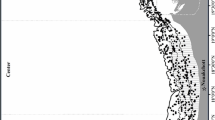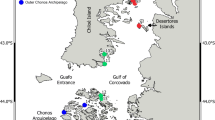Abstract
For many taxa, diversity, often measured as species richness, decreases with latitude. In this report patterns of diversity (species richness, species diversity, and evenness) in groundfish assemblages were investigated in relation to depth (200–1200 m) and latitude (33–47°N) on the continental slope of the U.S. Pacific coast. The data originated from the 1999–2002 upper continental slope groundfish surveys conducted by the National Marine Fisheries Service. When the data were pooled across depths, species density and evenness were found to decline with latitude. All three diversity measures declined with depth, with the lowest overall diversity in the 600- to 900-m depth range where longspine thornyhead Sebastolobus altivelis constituted close to 70% of the catch. When latitudinal gradients were examined within four depth zones (200–300 m, 400–500 m, 600–900 m, and 1000–1200 m) more complex patterns emerged. At depth species richness and evenness were inversely correlated with latitude as longspine thornyhead dominated catches to the north. However, in shallower areas of the slope, species richness and evenness were positively correlated with latitude. Latitudinal patterns of diversity in the deeper zones and when pooled across depths were positively correlated with temperature and broadly consistent with the Ambient Energy hypothesis discussed by Willig et al. [Annu Rev Ecol System 34:273–309 (2003)].
Similar content being viewed by others
References
Arreola-Robles JL, Elorduy-Garay JF (2002) Reef fish diversity in the region of La Paz, Baja California Sur, Mexico. Bull Mar Sci 70:1–18
Brown JH (1995) Macroecology. University of Chicago Press, Chicago
Builder Ramsey T, Turk TA, Fruh E, Wallace JR, Horness BH, Cook AJ, Bosley KL, Kamikawa DJ, Hufnagle LC, Piner K (2002) The 1999 Northwest Fisheries Science Center Pacific West Coast Upper Continental Slope Trawl Survey of Groundfish Resources off Washington, Oregon, and California: Estimates of Distribution, Abundance, and Length Composition. U.S. Department of Commerce, NOAA Technical Memo, NMFS-NWFSC-55
Colwell RK (2004) EstimateS: statistical estimation of species richness and shared species from samples. Version 7.5. User's guide and applications. Published at:http://purl.oclc.ore/estimates. Department of Ecology and Evolutionary Biology, University of Connecticut, Storrs
Colwell RK, Mau CX, Chang J (2004) Interpolation, extrapolation, and comparing incidence-based species accumulation curves. Ecology 85:2717–2727
Cowling RM, Samways JJ (1995) Predicting global patterns of endemic plant species richness. Biodivers Lett 2:127–131
Darwin C (1862) The voyage of the Beagle. Doubleday, Garden City
FAO (2003) Fisheries management. The ecosystem approach to fisheries. FAO Technical Guidelines for Responsible Fisheries. FAO, Rome
Fisher AG (1960) Latitudinal variations in organic diversity. Evolution 14:64–81
Gage JD, Tyler PA (1991) Deep-sea biology: a natural history of organisms at the deep-sea floor. Cambridge University Press, Cambridge
Garcia SM, Cochrane KL (2005) Ecosystem approach to fisheries: a review of implementation guidelines. ICES J Mar Sci 62:311–318
Gotelli NJ, Colwell RK (2001) Quantifying biodiversity: procedures and pitfalls in the measurement and comparison of species richness. Ecol Lett 4:379–391
Gray JS (1994) Is deep-sea species diversity really so high? Species diversity of the Norwegian continental shelf. Mar Ecol Progr Ser 112:205–209
Greenstreet SPR, Spence FE, McMillan JA (1999) Fishing effects in northeast Atlantic shelf seas: patterns in fishing effort, diversity and community structure. V. Changes in structure of North Sea groundfish species assemblage between 1925 and (1996). Fish Res 40:153–183
Haedrich RL, Merrett NR (1990) Little evidence for faunal zonation or communities in the deep sea demersal fish faunas. Progr Oceanogr 24:239–240
Haedrich, RL (1997) Distribution and population ecology. In: Randall DJ, Farrell AP (ed) Deep-sea fishes. Academic Press, San Diego, pp 79–114
Hilborn R (2004) Ecosystem-based fisheries management: the carrot or the stick?. Mar Ecol Progr Ser 274:275–278
Hillebrand H (2004) On the generality of the latitudinal diversity gradient. Am Nat 163:192–211
Hooper DU, Chapin FS III, Ewel JJ, Hector A, Inchausti P, Lavorel S, Lawton JH, Lodge DM, Loreau M, Naeem S, Shcmid B, Setälä H, Symstad AJ, Vandermeer J, Wardle DA (2005) Effects of biodiversity on ecosystem functioning: a consensus of current knowledge. Ecol Monogr 75:3–35
Horn MH, Allen LG (1978) A distributional analysis of California coastal marine fishes. J Biogeogr 5:23–42
Hurlbert SH (1971) The nonconcept of species diversity: a critique and alternative parameters. Ecology 52:577–586
Hutchinson GE (1957) Homage to Santa Rosalia, or why are there so many kinds of animals?. Am Nat 93:145–159
Jacobson LD, Hunter JR (1993) Bathymetric demography and management of Dover sole. North Am J Fish Manage 13:405–420
Jacobson LD, Vetter RD (1995) Bathymetric demography and niche separation of thornyhead rockfish: Sebastolobus alascanus and Sebastolobus altivelis. Can J Fish Aquat Sci 53:600–609
Jacobson LD, Brodziak J, Rogers J (2001) Depth distributions and time-varying bottom trawl selectivities for Dover sole (Microstomus pacificus), sablefish (Anoplopoma fimbria), and thornyheads (Sebastolobus alascanus and S. altivelis) in a commercial fishery. Fish Bull 99:309–327
Levitus S, Boyer TP (1994) World ocean atlas 1994, volume 2: oxygen. National Ocean and Atmospheric Administration, Washington D.C.
Littell RC, Miliken GA, Stroup WW, Wolfinger RD (1996) SAS system for mixed models. SAS Institute, Cary, N.C.
Lyons SK, Willig MR (2002) Species richness, latitude, and scale-sensitivity. Ecology 83:47–58
Mangel M, Levin PS (2005) Regime, phase and paradigm shifts: making community ecology the basic science for fisheries. Philos T Roy Soc Lond [Biol] 360:95–105
Margalef DR (1958) Information theory in ecology. Genet Syst 3:36–71
McClatchie S, Millar RB, Webster F, Lester PJ, Bagley N (1997) Demersal fish community diversity off New Zealand: is it related to depth, latitude, and regional surface phytoplankton? Deep-Sea Res 44:647–667
McCulloch CE, Searle RS (2001) Generalized, linear, and mixed models. John Wiley & Sons, New York
Merrett NR (1994) Reproduction in the North Atlantic oceanic ichthyofauna and the relationship between fecundity and species’ size. Environ Biol Fish 41:207–245
Mittermeier RA, da Fonsec GAB, Brooks T, Pilgrim J, Rodrigues A, Myers N (2003) Hotspots and coldspots. Am Sci 91:384–384
Mullins HT, Thompson JB, McDougall K, Vercoutere TL (1985) Oxygen-minimum zone edge effects: evidence from the central Californian coastal upwelling system. Geology 13:491–494
Myers N (2003) Biodiversity hotspots revisited. Bioscience 53:916–917
Myers N, Mittermeier RA, Mittermeier CG, da Fonesca GAB, Kent J (2003) Biodiversity hotspots for conservation priorities. Nature 403:853–858
NMFS (2003) Research plan for westcoast groundfish. National Marine Fisheries Service, NOAA, Seattle, Wash.
NRC (1998) Ecosystem-based management. Report to Congress. National Research Council. Ecosystem principles advisory panel. National Academy Press, Washington D.C.
Ojeda FP, Labra FA, Munoz AA (2000) Biogeographic patterns of Chilean littoral fishes. Rev Chilena Historia Nat 73:625–641
Olszewski TD (2004) A unified mathematical framework for the measurement of richness and evenness within and among multiple communities. Oikos 104:377–387
Pauly D, Christensen V, Froese R, Palomares ML (2000) Fishing down aquatic food webs. Am Sci 88:46–51
Pauly D, Christensen V, Guenette S, Pitcher TJ, Sumalia UR, Walters CJ, Watson R, Zeller D (2002) Towards sustainability in world fisheries. Nature 418:689–695
Pearcy WG, Stein DL, Carney R (1982) The deep-sea benthic fish fauna of the Northeastern Pacific ocean on Cascadia and Tufts Abyssal Plains and adjoining continental slopes. Biol Oceanogr 1:375–428
Pew Oceans Commission (2003) America’s living oceans: charting a course for sea change. A report to the nation. Pew Oceans Commission, Arlington, VA.
Rex MA (1981) Community structure in the deep sea benthos. Annu Rev Ecol System 12:331–353
Rex MA, Stuart CT, Hessler RR, Allen JA, Sanders HL, Wilson GFD (1993) Global-scale latitudinal patterns of species diversity in the deep-sea benthos. Nature 365:636–639
Rex MA, Stuart CT, Coyne G (2000) Latitudinal gradients of species richness in the deepsea benthos of the North Atlantic. Proc Natl Acad Sci USA 97:4082–4085
Rex MA, Crame JA, Stuart CT, Clarke A (2005) Large-scale biogeographic patterns in marine mollusks: a confluence of history and productivity. Ecology 86:2288–2297
Rose GA (2005) On distributional response of North Atlantic fish to climate change. ICES J Mar Sci 62:1360–1374
Rosenzweig ML (1995) Species diversity in space and time. Cambridge University Press, Cambridge
SAS Institute (2004) SAS OnlineDoc 9.1.3. SAS Institute, Cary, N.C.
SCCWRP (1973) The ecology of the Southern Californian bight: implications for water quality management. El Segundo, Calif. Southern California Coastal Water Research Project, Technical Report 104:1–531
Sigler MF, Lowe CR, Kastelle CR (1997) In: Wilkins ME, Saunders MS (eds) Area and depth differences in the age–length relationship of sablefish, Anoplopoma fimbria, in the Gulf of Alaska: biology and management of sablefish, Anoplopoma fimbria. U.S. Department of Commerce, NOAA Technical Report, NMFS 130, pp 55–63
Summers AC, Nybakken J (2000) Brittle star distribution patterns and population densities on the continental slope off central California (Echinodermata: Ophiuroidea). Deep-Sea Res II 47:1107–1137
Tabachnick BG, Fidell LS (1996) Using multivariate statistics. Harper Collins College, New York
Tolimieri N, Levin PS (2006) Assemblage structure of eastern Pacific groundfishes on the U.S. continental slope in relation to physical and environmental variables. Trans Am Fish Soc 135:115–130
Vetter RD, Lynn EA, Garza M, Costa AS (1994) Depth zonation and metabolic adaptation in Dover sole, Microstomus pacificus, and other deep-living flatfishes-factors that affect the sole. Mar Biol 120:145–159
Wallace AR (1878) Tropical nature and other essays. McMillan, London
Ward P, Myers RA (2005) Shifts in open-ocean fish communities coinciding with the commencement of commercial fishing. Ecology 86:835–847
Ware DM, Thomson RE (2005) Bottom-up ecosystem trophic dynamics determine fish production in the northeast Pacific. Science 308:1280–1284
Willig RM (2000) In: Levin S (ed) Latitude, common trends within, vol 3: Encyclopedia of biodiversity. Academic Press, San Diego, pp 701–714
Willig MR, Kaufam DM, Stevens RD (2003) Latitudinal gradients of biodiversity: pattern, process, scale, and synthesis. Annu Rev Ecol System 34:273–309
Woodd-Walker RS, Ward P, Clarke A (2002) Large-scale patterns in diversity and community structure of surface water copepods from the Atlantic Ocean. Mar Ecol Progress Ser 236:189–203
Worm B, Sandow M, Oschlies A, Lotze HK, Myers RA (2005) Global patterns of predator diversity in the open oceans. Science 309:1365–1369
Yang T-H, Somero GN (1993) Effects of feeding and food deprivation on oxygen consumption, muscle protein concentration and activities of energy metabolism enzymes in muscle and brain of shallow-living (Scorpaena guttata) and deep-living (Sebastolobus alascanus) scorpaenid fishes. J Exp Biol 181:213–232
Zabel RW, Harvey CJ, Katz SL, Good TP, Levin PS (2003) Ecologically sustainable yield. Am Sci 91:150–157
Acknowledgements
I thank P. Levin, I. Kaplan, P. Chittaro, J. Vavrinec, E. Clarke, C. Harvey, S. Katz, and three anonymous reviewers for comments on the manuscript. I greatly appreciate the work of the survey team that produced the data I used in this manuscript, and B. Horness for providing the data. B. Feist provided GIS help. L.A. Castus, K. Goar, F. Nerra III, W. Marshall, B. du Gesclin, J. Hawkwood, H. Baumgarten, B. Colleoni, F. Gonzaga, and G. de Cordova provided inspiration along the way.
Author information
Authors and Affiliations
Corresponding author
Rights and permissions
About this article
Cite this article
Tolimieri, N. Patterns in species richness, species density, and evenness in groundfish assemblages on the continental slope of the U.S. Pacific coast. Environ Biol Fish 78, 241–256 (2007). https://doi.org/10.1007/s10641-006-9093-5
Received:
Accepted:
Published:
Issue Date:
DOI: https://doi.org/10.1007/s10641-006-9093-5




